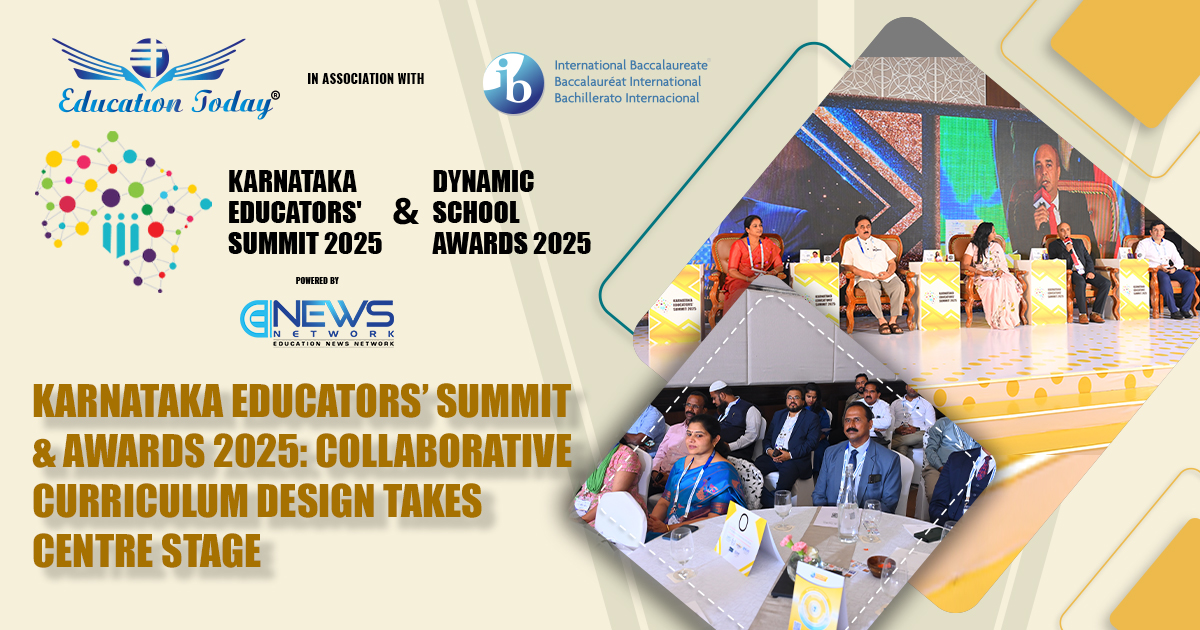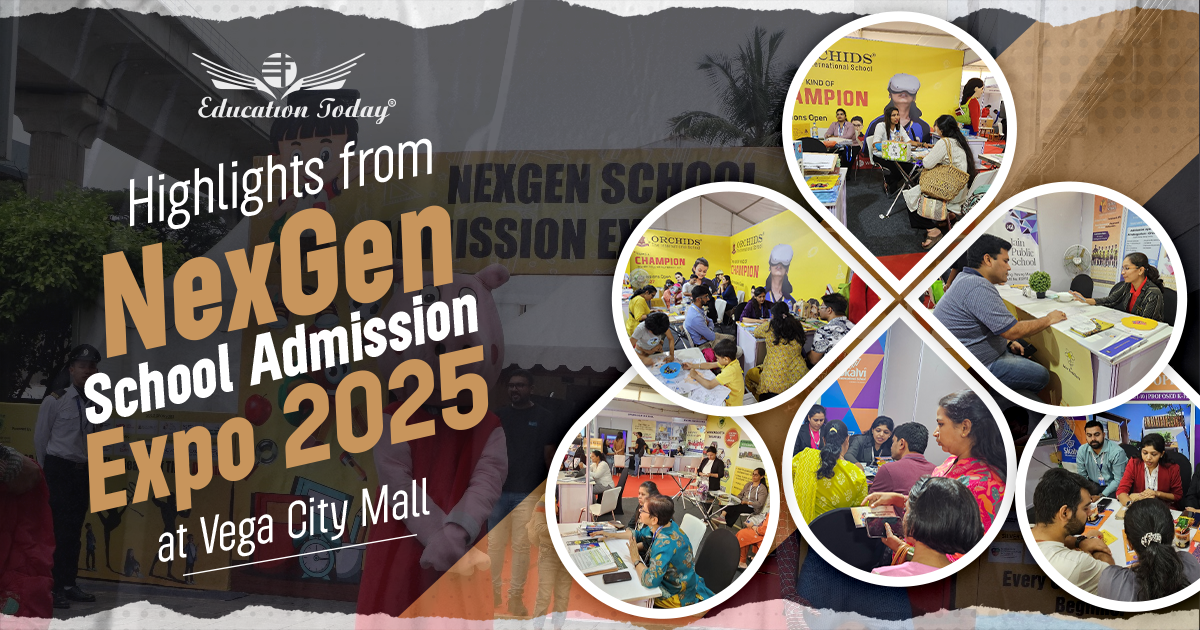Karnataka Educators’ Summit & Dynamic School Awards 2025: Collaborative Curriculum Design Takes Centre Stage
The Karnataka Educators’ Summit & Dynamic School Awards 2025, hosted by EducationToday in association with the International Baccalaureate (IB) and powered by the Education News Network, unfolded at the elegant Radisson Blu, Mysuru, on October 14, 2025. This marquee event brought together some of India’s most distinguished education leaders, educators, and innovators to deliberate on the future of learning, pedagogy, and holistic development.
Among the two insightful panels, one in particular stood out: “Collaborative Curriculum Design – Aligning Indian Classrooms with Global Learning Standards.” In a world increasingly defined by global interconnections, the panel probed how Indian schools can harmonise domestic education with international best practices, crafting curricula that not only cultivate global competencies but also remain deeply rooted in local culture and values.
Setting the Stage: The Moderator
The discussion was ably moderated by Ms. Suseela Santhosh, Director of the Vishwa Vidyapeeth Group of Schools and recognised as one of India’s Top 50 Effective Principals. Known for her innovative work in global classroom exchange programmes, teacher training, and holistic curriculum development, Ms. Santhosh opened the panel by emphasising the responsibility schools hold: “We are creating future citizens who are not just placed in India, but across the world.”
She posed a fundamental question: How can we collaboratively design a curriculum that is flexible, inclusive, and capable of responding to the dynamic needs of today’s students, without losing sight of our cultural roots?
The Panel of Visionaries
The panel comprised an eminent line-up of educators:
- Nadoja Dr. Wooday P. Krishna, Honorary General Secretary of Seshadripuram Educational Trust, celebrated scholar and social reformer.
- Ms. Brinda Srinivas, Founder & Director of Chimes Montessori and Tenbroeck Academy, advocate of child-centric and interdisciplinary learning.
- Mr. Rajeev Kumar Pargaien, Director of 10X International School, expert in IB and STEM-H education.
- Mr. Tanveer Ahmed, CEO of Little Flower Public School & Mitra Academy, champion of experiential learning and school leadership innovation.
Their perspectives collectively shed light on the essential pillars of collaborative curriculum design, blending tradition with modernity, and global standards with local relevance.
Collaboration Over Convention: Modern Curriculum Design
Mr. Rajeev Kumar Pargaien opened the discussion with a thought-provoking insight: “Collaborative curriculum is the outcome of collaboration itself.” He explained that unlike traditional curricula, which were designed top-down by principals or authorities, modern collaborative models involve all stakeholders: teachers, coordinators, students, parents, subject experts, and even industry partners.
He emphasised that in today’s volatile, uncertain, complex, and ambiguous—or “VUCA”—world, a curriculum must be continuously refined through feedback loops. “You design it, pivot it, collect the data, pivot again,” he explained. The goal is a curriculum that is culturally responsive, inclusive, and truly reflective of the diverse voices within the school community.
Mr. Pargaien further highlighted the evolution of teacher development. Traditionally, master trainers trained other educators who then imparted knowledge to classroom teachers. In the collaborative curriculum model (CCD), the very process of curriculum co-creation becomes a form of professional development for all stakeholders.
The Student at the Centre
Nadoja Dr. Wooday P. Krishna brought a reflective perspective, drawing on his own educational journey. “I was an obedient student, at the receiving end of a prescriptive curriculum. We did not understand the importance of collaborative learning until much later.” He traced the legacy of Indian education from the British colonial model to the present-day National Education Policy (NEP 2020), emphasising that students themselves should be consulted during curriculum design.
Dr. Krishna also stressed the careful integration of technology. While he acknowledged its inescapable presence, he was emphatic that technology should enable, not replace, the teacher. He pointed to the digital divide between urban and rural schools and noted that teacher resistance to new tools remains a key barrier. Ultimately, for him, the teacher remains central to conceptual learning, with technology serving a supportive role.
Cultural Roots and Inclusivity
Ms. Brinda Srinivas brought the discussion to the cultural and social dimension of curriculum design. “Collaborative curriculum is not a framework; it’s a mindset,” she remarked. In her vision, the child leads, the teacher guides, parents support, and the community enriches. Through this lens, curriculum becomes inclusive, culturally grounded, and globally aware.
Ms. Santhosh added that inclusivity extends beyond physical access or cognitive ability: “We must cultivate inclusiveness in both the mental and physical development of the child, enabling them to grow as global citizens without losing their cultural identity.”
Holistic Development Through Sports and Character Education
Mr. Tanveer Ahmed highlighted the role of physical education and sports in collaborative curricula. Reflecting on recent sporting events, he noted that sports teach discipline, leadership, healthy competition, and resilience. “A child’s psycho-motor development is integral to holistic learning,” he emphasised. Good teachers, especially in sports, can instil a lifelong love for activity while shaping character.
Dr. Krishna expanded on the importance of assessments in curriculum effectiveness. “The most important thing is to assess how much students have grasped.” Using varied assessment metrics, schools can ensure that teaching and learning outcomes remain aligned and that education is not just procedural but genuinely enriching.
The Value of Exposure and Global Learning
Tanveer Ahmed shared his personal experience with international student exchange programmes. Exposure to different assessment styles and cultural norms equips students with resilience and adaptability. “Children must learn to survive and thrive wherever they go, and this can be achieved only through education and exposure.”
Dr. Krishna returned to the philosophical roots of Indian education, highlighting the gurukula system, which emphasised moral and spiritual education alongside academics. He lamented that modern curricula often lose these essential elements in favour of mass education and secularism. Collaborative curricula, he argued, can restore the focus on character building by involving the wider community in shaping student values.
Holistic Learning and Teacher-Student Bonds
Ms. Srinivas likened collaborative curriculum to holistic education, integrating arts, life skills, and values. She drew attention to the personalised approach of traditional gurukula education, where the teacher knew the child intimately and ensured their successful progression. Modern education, she noted, sometimes lacks such personalised attention, and this is where collaborative curricula can bridge the gap.
Mr. Pargaien echoed this, noting that while the contexts differ—technology, AI, and globalisation now shape learning—the essence of teacher-student relationships remains. “If the CCD is implemented effectively, it aligns student needs with industry demands, fostering critical thinking and relevance.”
Integrating Values in Modern Education
Mr. Ahmed stressed the importance of maintaining value-based education within collaborative curricula. While technology, assessments, and globalisation have transformed classrooms, respect for teachers, moral education, and experiential learning must remain central. The panel agreed that collaborative curricula are not just about knowledge acquisition but about cultivating the character, resilience, and empathy of future citizens.
Ms. Santhosh concluded the discussion with a critical insight on teacher preparedness. “We continuously blame today’s children, but they are shaped by us. If teachers are not fully aware of the curriculum changes, they cannot implement them effectively.” She called for continuous professional development to ensure teachers are equipped to guide students in this new collaborative, culturally grounded, and globally relevant paradigm.
Conclusion: Towards a Collaborative Future
The panel on Collaborative Curriculum Design at the Karnataka Educators’ Summit 2025 highlighted a compelling vision for Indian education: one that marries the best of global standards with deep cultural grounding, inclusive practices, and holistic development.
From the insights of Dr. Krishna, Ms. Srinivas, Mr. Pargaien, and Mr. Ahmed, it is clear that the future of education lies in collaboration—among teachers, students, parents, communities, and industries. A curriculum that is flexible, culturally sensitive, technologically supported, and values-driven can equip Indian students not only to thrive in global contexts but also to become thoughtful, ethical, and resilient citizens.
As the summit drew to a close, attendees left with a renewed sense of purpose: that education is not merely about imparting knowledge, but about nurturing character, creativity, and competence. In this collaborative endeavour, every stakeholder—from teacher to policymaker—is a vital architect of the future.






